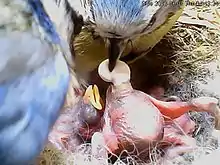Fecal sac
A fecal sac (also spelled faecal sac) is a mucous membrane, generally white or clear with a dark end,[1] that surrounds the feces of some species of nestling birds.[2] It allows parent birds to more easily remove fecal material from the nest. The nestling usually produces a fecal sac within seconds of being fed; if not, a waiting adult may prod around the youngster's cloaca to stimulate excretion.[3] Young birds of some species adopt specific postures or engage in specific behaviors to signal that they are producing fecal sacs.[4] For example, nestling curve-billed thrashers raise their posteriors in the air, while young cactus wrens shake their bodies.[5] Other species deposit the sacs on the rim of the nest, where they are likely to be seen (and removed) by parent birds.[4]



Not all species generate fecal sacs. They are most prevalent in passerines and their near relatives, which have altricial young[6] that remain in the nest for longer periods.[3] In some species, the fecal sacs of small nestlings are eaten by their parents. In other species, and when nestlings are older, sacs are typically taken some distance from the nest and discarded.[7] Young birds generally stop producing fecal sacs shortly before they fledge.[8]
Removal of fecal material helps to improve nest sanitation, which in turn helps to increase the likelihood that nestlings will remain healthy.[9] It also helps to reduce the chance that predators will see it or smell it and thereby find the nest.[10] Experiments on starling nests suggest that bacteria in faeces produce volatile chemicals that may provide cues for predators and ectoparasites such as flies in the genus Carnus.[11] There is evidence that parent birds of some species gain a nutritional benefit from eating the fecal sacs; studies have shown that females – which tend to be more nutritionally stressed than their mates – are far more likely to consume sacs than are males.[12] Even brood parasites such as brown-headed cowbirds, which do not care for their own offspring, have been documented swallowing the fecal sacs of nestlings of their host species.[13]
Scientists can use fecal sacs to learn a number of things about individual birds. Examination of the contents of the sac can reveal details of the nestling's diet,[14][15] and can indicate what contaminants the young bird has been exposed to.[16] The presence of an adult bird carrying a fecal sac is used in bird censuses as an indication of breeding.[17]
References
- Choiniere, J.; Mowbray Golding, C.; Vezo, T. (2005). What's That Bird?. Storey Publishing. p. 33. ISBN 1-58017-554-6.
- Elphick, C.; Dunning, Jr, J. B.; Sibley, D. (2001). The Sibley Guide to Bird Life & Behaviour. Christopher Helm. p. 78. ISBN 0-7136-6250-6.
- Campbell, B.; Lack, E. (1985). A Dictionary of Birds. T. & A. D. Poyser. p. 433. ISBN 0-85661-039-9.
- O'Connor, R. J. (1984). The Growth and Development of Birds. Wiley Interscience. p. 174. ISBN 0-471-90345-0.
- Ricklefs, R. E. (1996). "Behavior of Young Cactus Wrens and Curve-billed Thrashers" (PDF). The Wilson Bulletin. 78 (1): 47–56. Archived from the original (PDF) on 2008-10-10. Retrieved 2009-12-17.
- Ibáñez-Álamo, Juan Diego; Rubio, Enrique; Soler, Juan José (2017). "Evolution of nestling faeces removal in avian phylogeny". Animal Behaviour. 124: 1–5. doi:10.1016/j.anbehav.2016.11.033. hdl:10261/143037. S2CID 53194945.
- Ehrlich, P. R; Dobkin, D. S; Wheye, D.; Pimm, S. L. (1994). The Birdwatcher's Handbook. Oxford University Press. p. 75. ISBN 0-19-858407-5.
- Mockler, M. (1992). Birds in the Garden. Orion Books. p. 61. ISBN 1-85079-217-8.
- Alcorn, G. D. (1991). Birds and Their Young. Stackpole Books. p. 177. ISBN 0-8117-1016-5.
- Read, M. (2005). Secret Lives of Common Birds. Houghton Mifflin Harcourt. p. 45. ISBN 0-618-55871-3.
- Azcárate‐García, Manuel; Ruiz‐Rodríguez, Magdalena; Díaz‐Lora, Silvia; Ruiz‐Castellano, Cristina; Soler, Juan José (2019). "Experimentally broken faecal sacs affect nest bacterial environment, development and survival of spotless starling nestlings". Journal of Avian Biology. 50 (3): jav.02044. doi:10.1111/jav.02044. ISSN 0908-8857. S2CID 198238633.
- McGowan, K. J. (1995). "A Test of Whether Economy or Nutrition Determines Fecal Sac Ingestion in Nesting Corvids" (PDF). The Condor. 97 (1): 50–56. doi:10.2307/1368982. JSTOR 1368982.
- Stake, M. M.; Cavanagh, P. M. (2001). "Removal of Host Nestlings and Fecal Sacs by Brown-headed Cowbirds". The Wilson Bulletin. 113 (4): 456–459. doi:10.1676/0043-5643(2001)113[0456:ROHNAF]2.0.CO;2. S2CID 88221603.
- Brickle, N. W.; Harper, D. G. C. (1999). "Diet of Nestling Corn Buntings Miliaria Calandra in Southern England Examined by Compositional Analysis of Faeces". Bird Study. 46 (3): 319–329. doi:10.1080/00063659909461145.
- Smith, G. T.; Calver, M. C. (1984). "The Diet of the Nestling Noisy Scrub-Bird, Atrichornis Clamosus". Australian Wildlife Research. 11 (3): 553–558. doi:10.1071/WR9840553.
- Custer, T. W.; Custer, C. M.; Stromborg, K. L. (1997). "Distribution of Organochlorine Contaminants in Double-crested Cormorant Eggs and Sibling Embryos". Environmental Toxicology and Chemistry. 16 (8): 1646–1649. doi:10.1002/etc.5620160812. S2CID 9042213.
- Bibby, C. J. (2000). Bird Census Techniques (2nd ed.). Elsevier. p. 302. ISBN 0-12-095831-7.